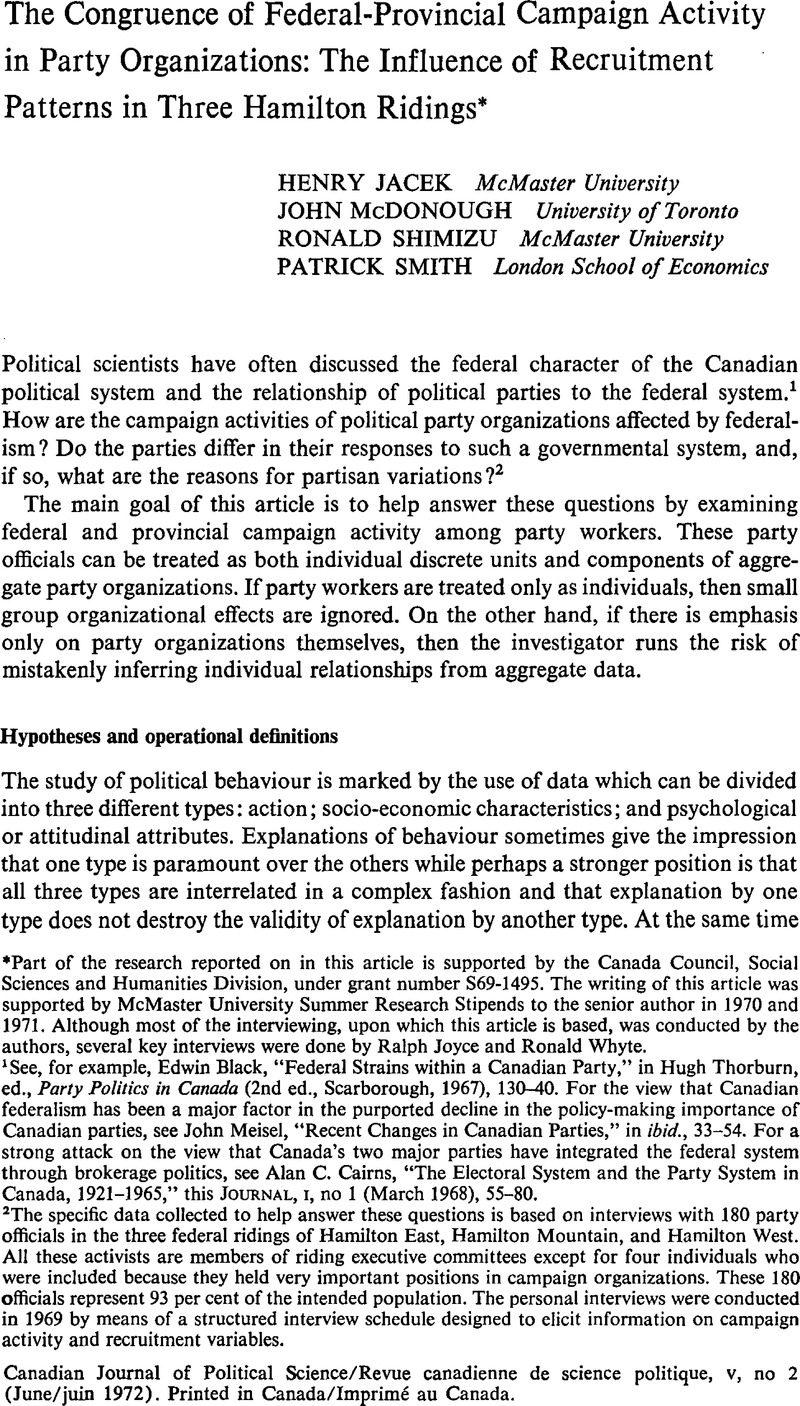Article contents
The Congruence of Federal-Provincial Campaign Activity in Party Organizations: The Influence of Recruitment Patterns in Three Hamilton Ridings*
Published online by Cambridge University Press: 10 November 2009
Abstract

- Type
- Articles
- Information
- Canadian Journal of Political Science/Revue canadienne de science politique , Volume 5 , Issue 2 , June 1972 , pp. 190 - 205
- Copyright
- Copyright © Canadian Political Science Association (l'Association canadienne de science politique) and/et la Société québécoise de science politique 1972
References
1 See, for example, Black, Edwin, “Federal Strains within a Canadian Party,” in Thorburn, Hugh, ed., Party Politics in Canada (2nd ed., Scarborough, 1967), 130–40.Google Scholar For the view that Canadian federalism has been a major factor in the purported decline in the policy-making importance of Canadian parties, see John Meisel, “Recent Changes in Canadian Parties,” in ibid., 33–54. For a strong attack on the view that Canada's two major parties have integrated the federal system through brokerage politics, see Cairns, Alan C., “The Electoral System and the Party System in Canada, 1921–1965,” this JOURNAL, I, no 1 (March 1968), 55–80.Google Scholar
2 The specific data collected to help answer these questions is based on interviews with 180 party officials in the three federal ridings of Hamilton East, Hamilton Mountain, and Hamilton West. All these activists are members of riding executive committees except for four individuals who were included because they held very important positions in campaign organizations. These 180 officials represent 93 per cent of the intended population. The personal interviews were conducted in 1969 by means of a structured interview schedule designed to elicit information on campaign activity and recruitment variables.
3 This typology is similar to that developed by Clark, Peter and Wilson, James Q.; see their “Incentive Systems: A Theory of Organizations,” Administrative Science Quarterly, VI (1961), 129–67CrossRefGoogle Scholar, and Wilson, , The Amateur Democrat (Chicago, 1962).Google Scholar
4 This orientation is best explained by Robert Merton. He distinguished the localite – whose interest is “confined to his community,” which is essentially his world, who is preoccupied with local problems, who is “parochial” – from the cosmopolitan – who is “oriented significantly to the world outside his community,” who regards himself as an integral part of the world, and who is “ecumenical.” See “Types of Influentials: Local and Cosmopolitan,” in Banfield, Edward, ed., Urban Government (New York, 1961), 390.Google Scholar
5 Methods of recruitment have been emphasized by political scientists studying the selection of candidates for office. See, for example, Seligman, Lester, “Political Recruitment and Party Structure: A Case Study,” American Political Science Review, LV no 2 (March 1961), especially 85–6.Google Scholar Seligman distinguishes between two types of external recruitment which distinction appears important in understanding candidate-selection but is less relevant in studying the involvement of political workers. The concept of recruitment methods has been used before in studying Canadian politicians. See Hoffman, David and Ward, Norman, Bilingualism and Biculturalism in the Canadian House of Commons, Documents of the Royal Commission on Bilingualism and Biculturalism (Ottawa, 1970), 61.Google Scholar
6 When level of activity is collapsed into two categories, single- and two-level activists, no overall association, however, with riding occurs.
7 A good understanding of the conservative interpretation of tables by the Goodman and Kruskal tau-alpha can be gained by examining closely Table VIII. On the face of the table it would appear that there is a very strong relationship between the two variables, yet our predictability is increased only 36 per cent. Three identical distributions of data with nominal, ordinal, and interval characteristics would produce far larger coefficients if ordinal or interval measures were used. Thus, when one uses the Goodman and Kruskal tau-alpha, an investigator is less likely to overestimate the strength of relationships than if he were to use other more common statistics.
8 Canadian Labour in Politics (Toronto, 1968), 27.
9 Peter Clark and James Q. Wilson applied their system of incentives to organizations. Groups which rely upon material incentives are called utilitarian organizations. An organization in which status, prestige, and fellowship are the main benefits is seen as a solidarity group. Finally, a group with ideological incentives as the dominant reward is called a purposive organization. Wilson, in The Amateur Democrat, groups utilitarian and solidarity organizations into the professional category and calls the purposive group an amateur organization.
10 “Corruption, Machine Politics and Political Change,” American Political Science Review, LXIII, no 4 (Dec. 1969), 1142–58, especially 1146.
11 The Conservative party may be able to keep its organizational strength even if it fails to form the provincial government. A general demoralization may not set in until the party is in opposition for more than two consecutive terms. On this point, see Wilson, John and Hoffman, David, “Ontario: A Three Party System in Transition,” in Robin, Martin, ed., Canadian Provincial Politics (Scarborough, 1972).Google Scholar
- 4
- Cited by




